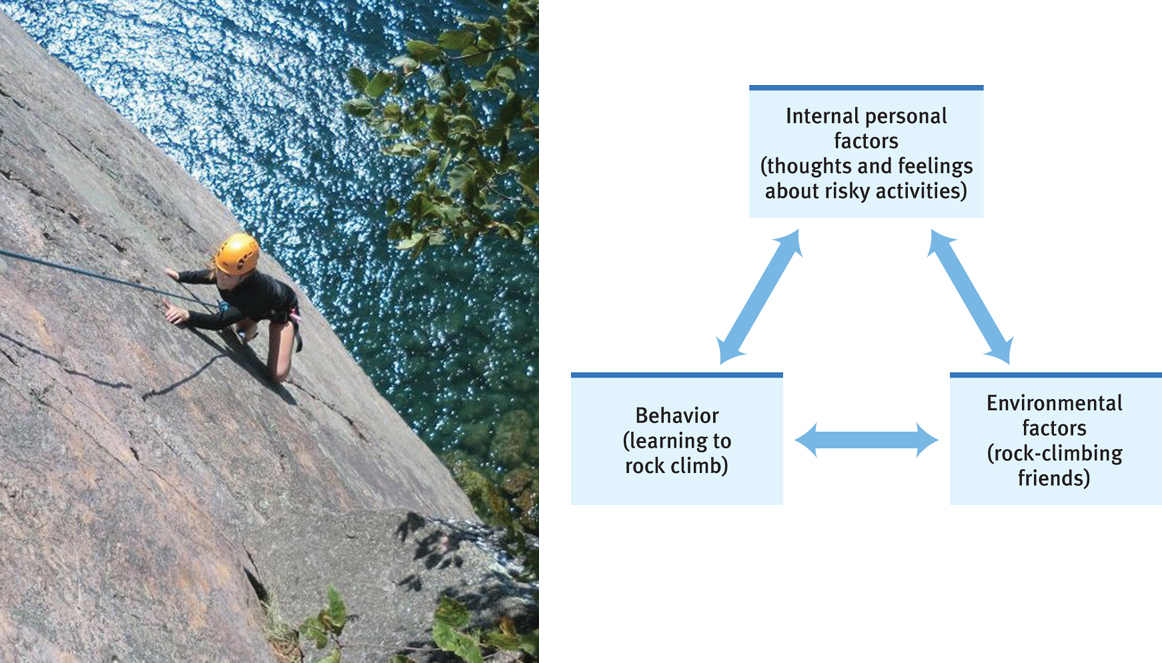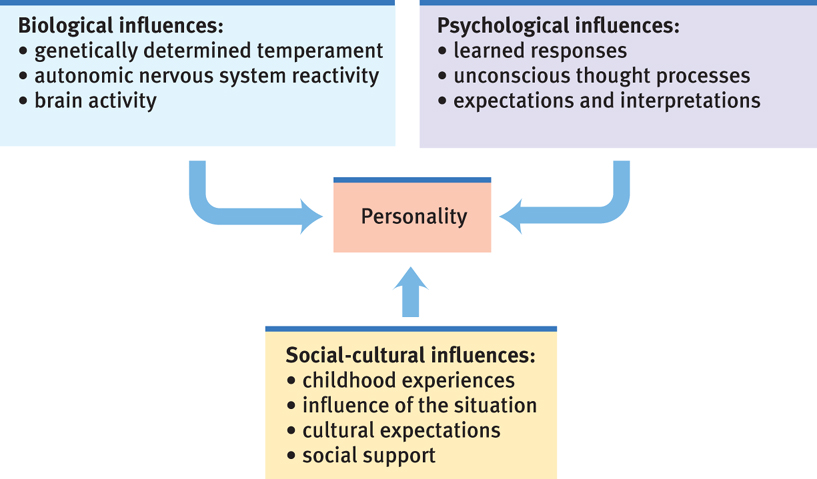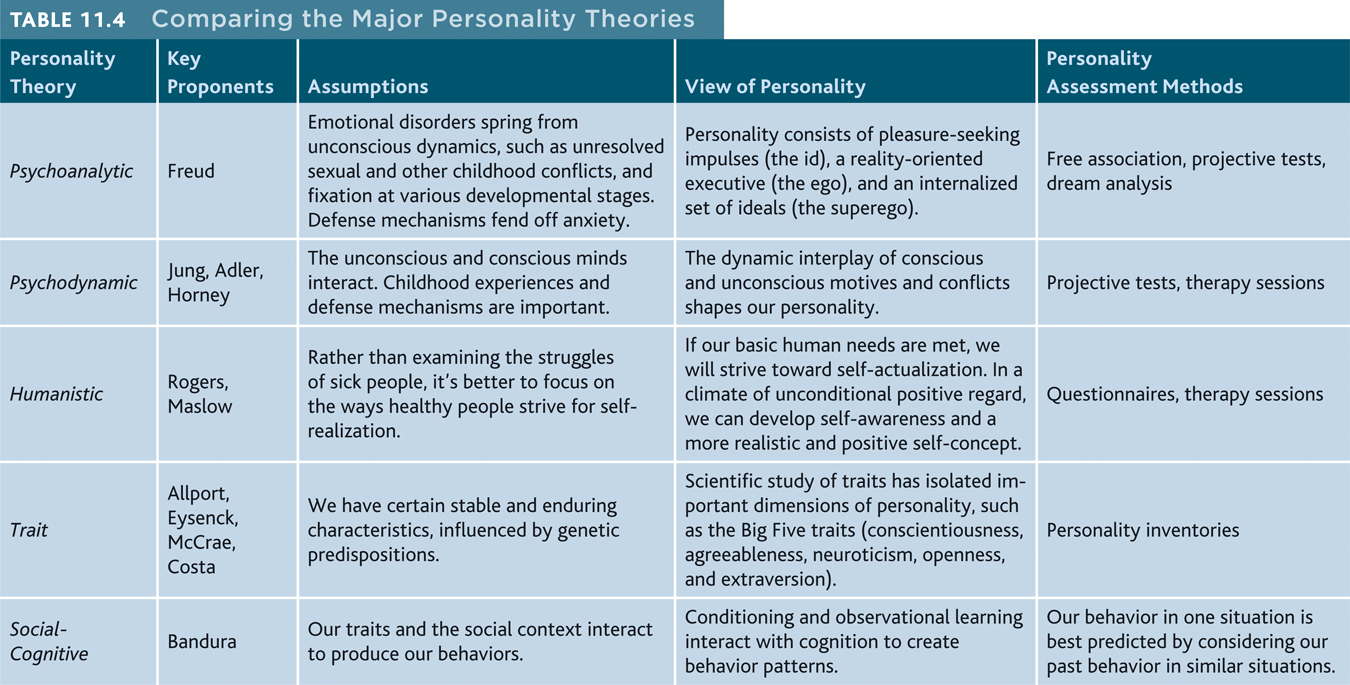Social-Cognitive Theories
11-16 How do social-cognitive theorists view personality development, and how do they explore behavior?
Reciprocal Influences
 So, our personal traits interact with our environment to influence our behavior. Albert Bandura (1986, 2006, 2008) called this process reciprocal determinism. “Behavior, internal personal factors, and environmental influences,” he said, “all operate as interlocking determinants of each other” (FIGURE 11.4) .
So, our personal traits interact with our environment to influence our behavior. Albert Bandura (1986, 2006, 2008) called this process reciprocal determinism. “Behavior, internal personal factors, and environmental influences,” he said, “all operate as interlocking determinants of each other” (FIGURE 11.4) .

The social-cognitive theories of personality (including Bandura’s and others) are especially focused on in the many ways our individual traits and thoughts interact with our social world as we move from one situation to another. We bring a lot to any social situation we enter. We bring our past learning, often picked up through conditioning or by observing others. We bring our self-efficacy—our expectations about whether we will succeed in (and attempt) new challenges (Bandura, 1977). We also bring our ways of thinking about specific situations. But situations themselves place different demands on us. Most of us know the general social rules for acceptable behavior at a grandparent’s funeral, for example. We also know that a different set of rules outlines what’s acceptable at a friend’s New Year’s Eve party. In the end, our behavior in any situation is in part the result of our own characteristics and in part the result of the situation.
327
For psychologists who study personality from a social-cognitive perspective, this interaction is a fascinating area of research. Roughly speaking, the short-term, outside influences on behavior are the focus of social psychology (Chapter 12), and the lasting, inner influences are the focus of personality psychology. In actuality, behavior always depends on the interaction of persons with situations.
We can see this interaction in the habits people develop in relationships. For example, Romena’s history of romantic relationships (past behavior) influences her attitudes toward relationships in general (internal factor), which impacts how she now responds to Jordan (environmental factor). Social-cognitive theorists explore the interaction among the three sets of influence:
- Different people choose different environments. What school do you attend? What do you read? What shows do you watch? What music do you listen to? With whom do you enjoy spending time? All these choices are part of an environment you are choosing, based partly on your personality (Ickes et al., 1997). We choose our environment, and then it shapes us.
- Our personalities shape how we interpret and react to events. Anxious people tend to attend and react strongly to relationship threats (Campbell & Marshall, 2011). If we perceive the world as threatening, we will watch for threats and be prepared to defend ourselves.
- Our personalities help create situations to which we react. How we view and treat people influences how they then treat us. If we expect that others will not like us, our desperate attempts to seek their approval might cause them to reject us. Depressed people often engage in this excessive reassurance seeking, which confirms their negative self-views (Coyne, 1976a, b).
In addition to the interaction of internal personal factors, the environment, and our behaviors, we also experience heredity-environment interaction (Chapter 3). Our genetically influenced traits evoke certain responses from others, which may nudge us in one direction or another. In one classic study, those with the interacting factors of (1) having a specific gene associated with aggression, and (2) being raised in a difficult environment were most likely to demonstrate adult antisocial behavior (Caspi et al., 2002).
In such ways, we are both the products and the architects of our environments. Boiling water turns an egg hard and a noodle soft. Academic challenges turn one person into a success and another toward collapse (Harms et al., 2006). At every moment, our behavior is influenced by our biology, our social and cultural experiences, and our thought processes and traits (FIGURE 11.5) .

328
Assessing Behavior in Situations
To predict behavior, social-cognitive psychologists often observe behavior in realistic situations.
Military and educational organizations and many Fortune 500 companies are using such strategies (Bray & Byham, 1991, 1997; Eurich et al., 2009). AT&T has observed prospective managers doing simulated managerial work. Many colleges assess students’ potential via internships and student teaching and assess potential faculty members’ teaching abilities by observing them teach. Armies assess their soldiers by observing them during military exercises. Most American cities with populations of 50,000 or more have used such strategies in evaluating police officers and firefighters (Lowry, 1997).
These assessment exercises have some limitations. They may not reveal less visible but important characteristics, such as inner achievement drive (Bowler & Woehr, 2006). These procedures do exploit a valid principle: The best way to predict future behavior is neither a personality test nor an interviewer’s intuition; rather, it is the person’s past behavior patterns in similar situations (Mischel, 1981; Ouellette & Wood, 1998; Schmidt & Hunter, 1998).
Evaluating Social-Cognitive Theories
11-17 What criticisms have social-cognitive theorists faced?

Social-cognitive theories of personality emphasize how situations affect, and are affected by, individuals. More than other personality theories (TABLE 11.4), they build from psychological research on learning and cognition.
Critics charge that social-cognitive theories focus so much on the situation that they fail to appreciate the person’s inner traits. They note that in many instances our unconscious motives, our emotions, and our traits shine through. Personality traits have been shown to predict behavior at work, love, and play. Consider Percy Ray Pridgen and Charles Gill. Each faced the same situation: They had jointly won a $90 million lottery jackpot (Harriston, 1993). When Pridgen learned of the winning numbers, he began trembling uncontrollably, huddled with a friend behind a bathroom door while confirming the win, then sobbed. When Gill heard the news, he told his wife and then went to sleep. 
RETRIEVE + REMEMBER
Question 11.11
According to the social-cognitive perspective, what is the best way to predict a person’s future behavior?
Examine the person’s past behavior patterns in similar situations.
